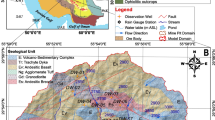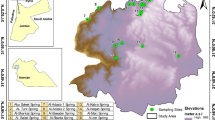Abstract
The impact of groundwater heat pumps on groundwater temperature is simulated by means of a 2D numerical groundwater model in the Leibnitzer Feld aquifer, Austria. The model provides a basis for assessing the regional use of groundwater temperature as an energy source. Since the groundwater table is shallow, the air temperature represents the main source controlling the groundwater temperature. A temperature input function depending on the depth of the groundwater table is delineated from an observed soil temperature profile and the air temperature. Given the diffuse and ubiquitous nature of the heat input, the heat exchange is implemented as a third type boundary condition to enable two-way heat transfer. The temperature of the reinjected water is limited to a decrease of 5 K and an absolute minimum of 5°C by Austrian law. The pumping rates needed to cover the heat requirements of three typical users are determined for selected locations. It is shown that the reduction of the ambient groundwater temperature approximately 300 m downstream of the reinjection wells is less than 0.5°C. Thus it can be concluded that aquifers in similar settings show substantial potential to provide heating and warm water supply for buildings without deteriorating the regional groundwater temperature regime.










Similar content being viewed by others
References
Allen DM, Woo C, Shymko GF, Maynord S (2000) Operating strategies for ATES in areas with non-ideal climates. In: TERRASTOCK 2000 8th international conference on thermal energy storage. Stuttgart, Germany, pp 93–98, ISBN 3-9805274-1-7
de Marsily G (1986) Quantitative hydrogeology. Academic Press, San Diego
Deutsche Forschungsgemeinschaft (DFG) (1992) Schadstoffe im Grundwasser Band 1 Wärme- und Schadstofftransport im Grundwasser (Pollutants in groundwater Part 1 Heat- and pollutant transport in groundwater). VCH Verlagsgesellschaft mbH, Weinheim
Diersch HG (1998) FEFLOW reference manual. WASY GmbH, Berlin
Dupasquier S, Parriaux A (2000) Parametric study of a single-well seasonal ATES. In: TERRASTOCK 2000 8th international conference on thermal energy storage. Stuttgart, Germany, pp 99–104, ISBN 3-9805274-1-7
Dwyer TE, Eckstein Y (1987) Finite-element simulation of low-temperature, heat-pump-coupled, aquifer thermal energy storage. J Hydrol 95:19–38
Fank J (1999) Die Bedeutung der ungesättigten Zone für Grundwasserneubildung und Nitratbefrachtung des Grundwassers in quartären Lockersediment-Aquiferen am Beispiel des Leibnitzer Feldes (The significance of the unsaturated zone for groundwater recharge and nitrate leaching into the groundwater of quaternary porous aquifers at the example of the Leibnitzer Feld). Beiträge zur Hydrogeologie 49/50:101–388
Fank J, Fuchs K (1996) Optimierung des Grundwassermessstellennetzes und Auswahl charakteristischer Messstellen im Leibnitzer Feld (Optimization of the groundwater monitoring network and determination of characteristic monitoring wells in the Leibnitzer Feld). Mitteilungsblatt des Hydrographischen Dienstes in Österreich 74:1–58
Fank J, Jawecki A, Nachtnebel HP, Zojer H (1993) Hydrogeologie und Grundwassermodell des Leibnitzer Feldes. (Hydrogeology and groundwater model of the Leibnitzer Feld). Berichte der wasserwirtschaftlichen Planung Band 74/1, Amt der Steiermärkischen Landesregierung, Landesbaudirektion Fachabteilung IIIa—Wasserwirtschaft und Bundesministerium für Land- und Forstwirtschaft Wasserwirtschaftskataster, Graz, Wien
Molson JW, Frind EO, Palmer CD (1992) Thermal energy storage in an unconfined aquifer 2. model development, validation and application. Water Resour Res 28:2857–2867
Sykes JF, Lantz RB, Pahwa SB, Ward DS (1982) Numerical simulation of thermal energy storage experiment conducted by Auburn University. Ground Water 20:569–576
Warner DL, Algan U (1984) Thermal impact of residential ground-water heat pumps. Ground Water 22:6–12
Acknowledgments
Part of this work has been funded by the Province of Styria and the EU under contract no. AAW-11G4-96/2. Hans Fank substantially contributed to the work and provided much of the data.
Author information
Authors and Affiliations
Corresponding author
Rights and permissions
About this article
Cite this article
Kupfersberger, H. Heat transfer modelling of the Leibnitzer Feld aquifer, Austria. Environ Earth Sci 59, 561–571 (2009). https://doi.org/10.1007/s12665-009-0054-0
Received:
Accepted:
Published:
Issue Date:
DOI: https://doi.org/10.1007/s12665-009-0054-0




